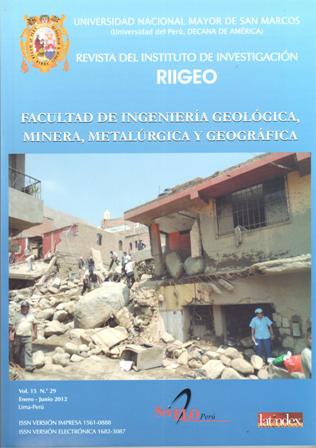Construction of jetties igneous rocks land to sea, in the Chira, Paso Spider, Jumping the Fraile and La Punta. Lima, Peru
DOI:
https://doi.org/10.15381/iigeo.v15i29.2202Keywords:
Marine breakwaters, igneous rocks, Jump FriarAbstract
This research proposes the construction of four piers, three of 100m and one of 200m using dioritic igneous rock type or andesites outcropping in the basin of the river Rimac and Chillon. To construct the breakwaters of igneous rocks from land to sea taking to support the rocky spurs of the beach La Chira, Paso spiders, jumping the Fraile and La Punta, proposals igneous rocks have been subjected to mechanical tests, and petrological studies in film thin, thereby demonstrating good texture and excellent packaging or factory and are not affected by the attacks of the hydrochloric acid (HCl) and nitric acid (HNO3) used to simulate the marine environment. In the beach area is proposed to build four jetties, the first jetty will be located on the spur of quartzite on the beach of La Chira, the second pier on the spur of gray sandstone height Step Spider, the third breakwater in Jump ram gray sandstone Friar, where there is a strong inflection of the waterfront pier and the fourth in the South of La Punta industry, the dynamics of the construction of these jetties will be staggered, moving from land to sea, building first its axis, using moles of dioritic and andesitic rocks then placed on their sides, and small blocks overs finally enchapar antecoraza and the breastplate, diorites and andesites moles, these piers could easily exceed a lifespan of 150 years.Downloads
Published
Issue
Section
License
Copyright (c) 2012 Tomás Gallarday Bocanegra

This work is licensed under a Creative Commons Attribution-NonCommercial-ShareAlike 4.0 International License.
AUTHORS RETAIN THEIR RIGHTS:
a. Authors retain their trade mark rights and patent, and also on any process or procedure described in the article.
b. Authors retain their right to share, copy, distribute, perform and publicly communicate their article (eg, to place their article in an institutional repository or publish it in a book), with an acknowledgment of its initial publication in the Rev. Inst. investig. Fac. minas metal cienc. geogr.
c. Authors retain theirs right to make a subsequent publication of their work, to use the article or any part thereof (eg a compilation of his papers, lecture notes, thesis, or a book), always indicating the source of publication (the originator of the work, journal, volume, number and date).






